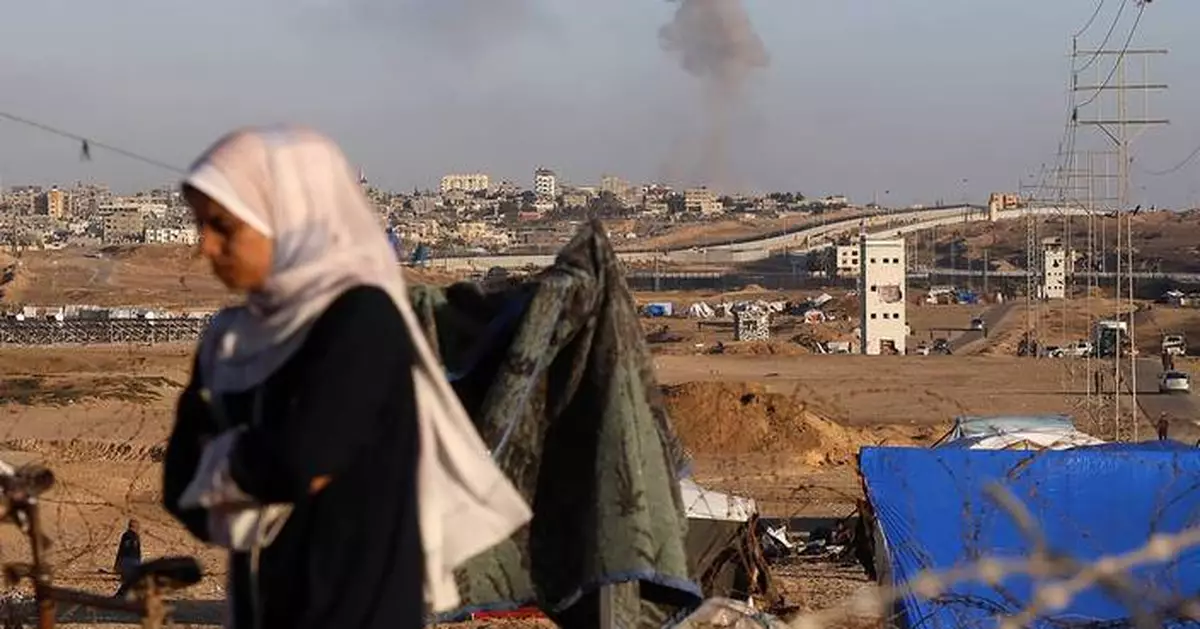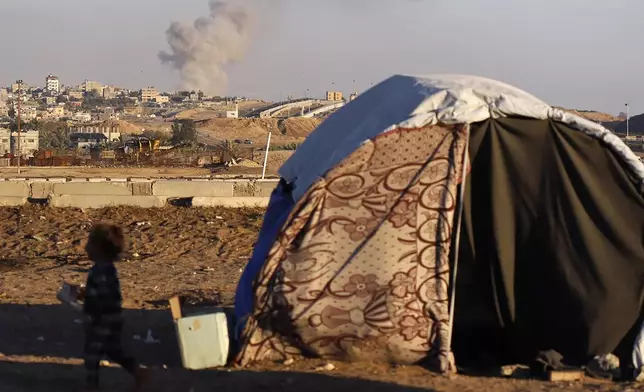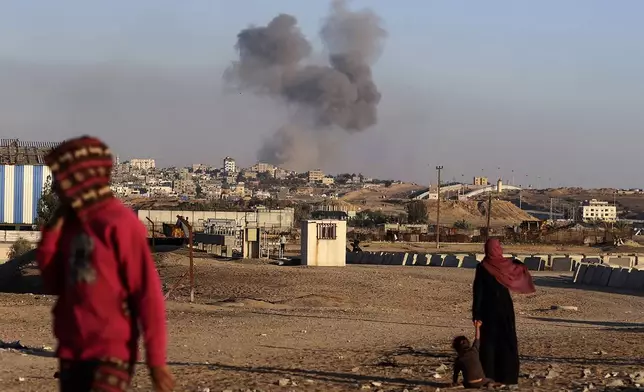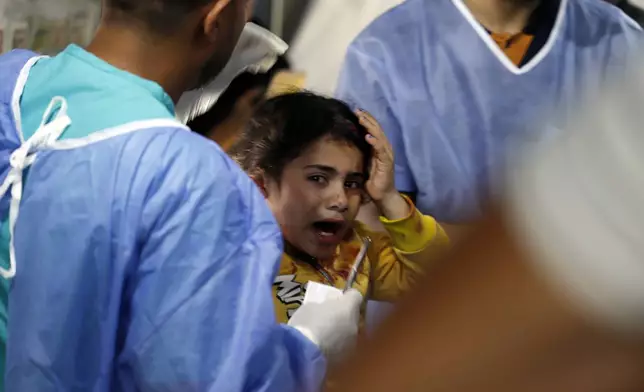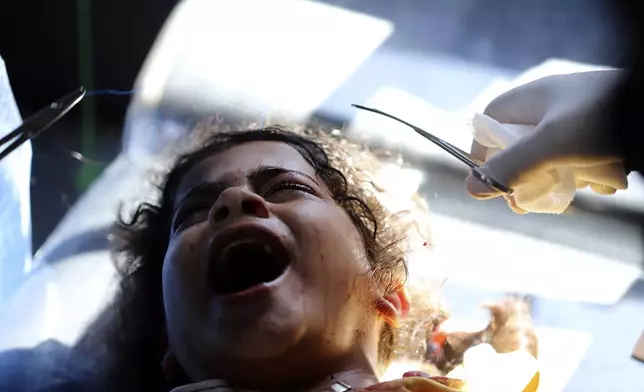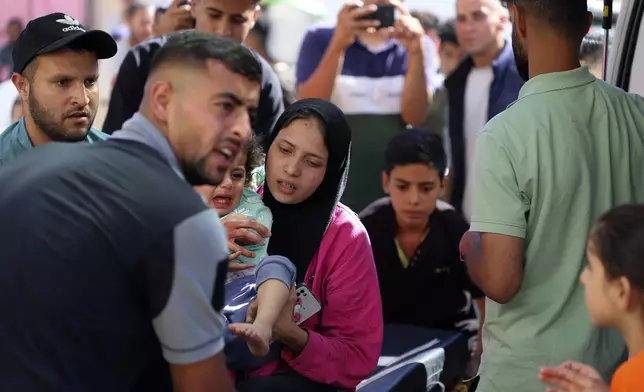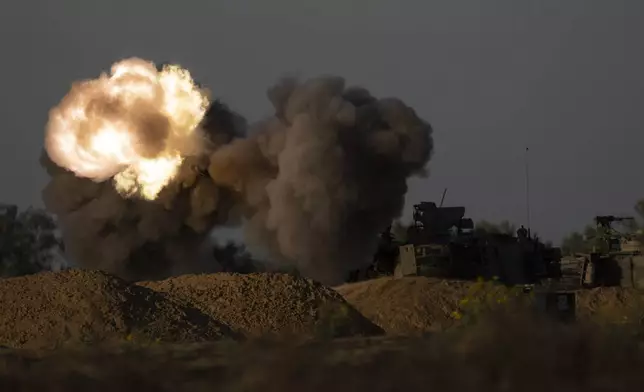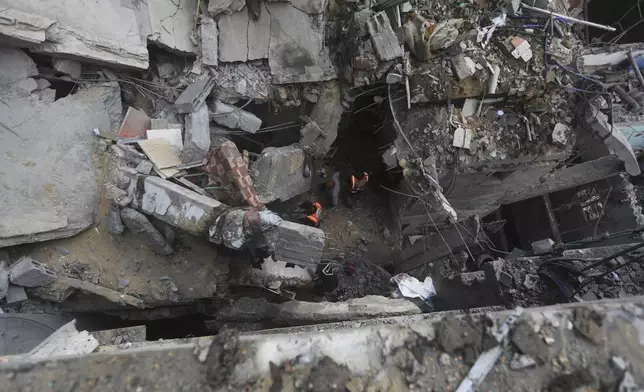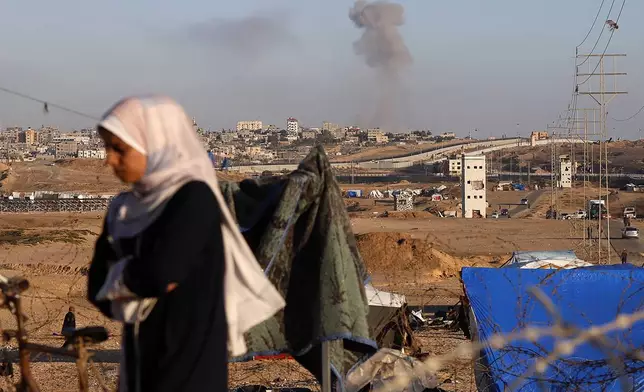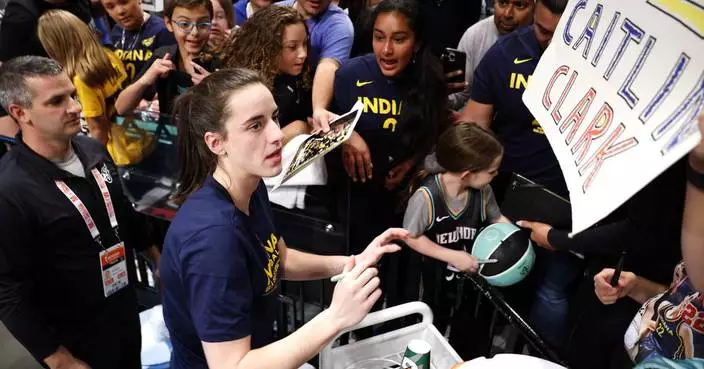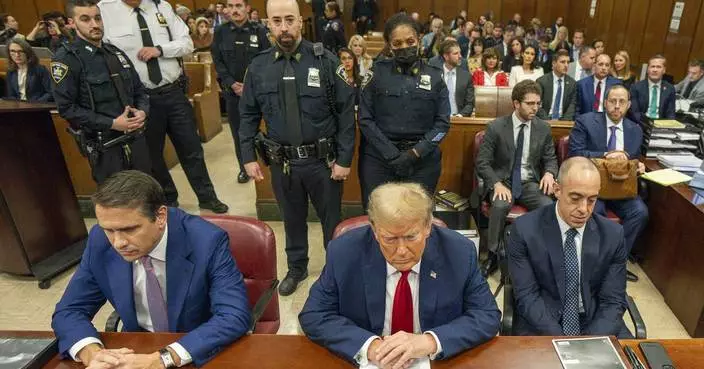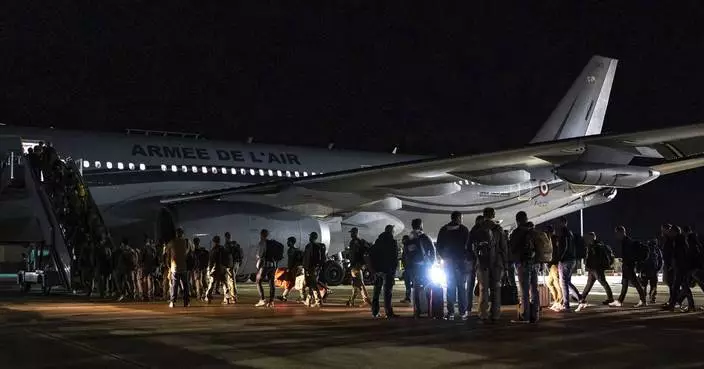CAIRO (AP) — Israeli troops seized control of Gaza’s vital Rafah border crossing on Tuesday in what the White House described as a limited operation, as fears mount of a full-scale invasion of the southern city and talks with Hamas over a cease-fire and hostage release remain on a knife’s edge.
The U.N. warned of a potential collapse of the flow of aid to Palestinians from the closure the Rafah crossing from Egypt and the other main crossing into Gaza, Kerem Shalom, from Israel, at a time when U.N. officials say northern Gaza is experiencing “full-blown famine.”
Click to Gallery
CAIRO (AP) — Israeli troops seized control of Gaza’s vital Rafah border crossing on Tuesday in what the White House described as a limited operation, as fears mount of a full-scale invasion of the southern city and talks with Hamas over a cease-fire and hostage release remain on a knife’s edge.
Smoke rises following an Israeli airstrike on buildings near the separating wall between Egypt and Rafah, southern Gaza Strip, Tuesday, May 7, 2024. (AP Photo/Ramez Habboub)
Smoke rises following an Israeli airstrike on buildings near the separating wall between Egypt and Rafah, southern Gaza Strip, Tuesday, May 7, 2024. (AP Photo/Ramez Habboub)
Palestinian medics treat a girl wounded in the Israeli bombardment of the Gaza Strip at the Kuwaiti Hospital in Rafah refugee camp, southern Gaza, Tuesday, May 7, 2024. (AP Photo/Ramez Habboub)
Palestinian medics treat a girl that was wounded in the Israeli bombardment of the Gaza Strip at the Kuwaiti Hospital in Rafah refugee camp, southern Gaza, Tuesday, May 7, 2024. (AP Photo/Ramez Habboub)
A Palestinian child is brought to the Kuwaiti Hospital after being wounded in the Israeli bombardment of the Gaza Strip, in Rafah refugee camp, southern Gaza, Tuesday, May 7, 2024. (AP Photo/Ramez Habboub)
An Israeli mobile artillery unit fires a shell from southern Israel towards the Gaza Strip, in a position near the Israel-Gaza border, Tuesday, May 7, 2024. (AP Photo/Leo Correa)
Palestinians mourn their relatives killed in the Israeli bombardment in Rafah, Gaza Strip, Tuesday, May 7, 2024. (AP Photo/Ismael Abu Dayyah)
Palestinians look at the destruction after an Israeli strike on residential building in Rafah, Gaza Strip, Tuesday, May 7, 2024. (AP Photo/Ismael Abu Dayyah)
Palestinians look at the destruction after an Israeli strike on residential building in Rafah, Gaza Strip, Tuesday, May 7, 2024. (AP Photo/Ismael Abu Dayyah)
Palestinians look at the destruction after an Israeli strike on residential building in Rafah, Gaza Strip, Tuesday, May 7, 2024. (AP Photo/Ismael Abu Dayyah)
A Palestinian wounded in the Israeli bombardment of the Gaza Strip is brought to a hospital in Rafah, southern Gaza Strip, Tuesday, May 7, 2024. (AP Photo/Ismael Abu Dayyah)
Palestinians mourn their relatives killed in the Israeli bombardment in Rafah, Gaza Strip, Tuesday, May 7, 2024. (AP Photo/Ismael Abu Dayyah)
Palestinians look at the destruction after an Israeli strike on residential building in Rafah, Gaza Strip, Tuesday, May 7, 2024. (AP Photo/Ismael Abu Dayyah)
Palestinians look at the destruction after an Israeli strike on residential building in Rafah, Gaza Strip, Tuesday, May 7, 2024. (AP Photo/Ismael Abu Dayyah)
This photo provided by the Israel Defense Forces shows a tank with an Israel flag on it entering the Gazan side of the Rafah border crossing on Tuesday, May 7, 2024. (Israel Defense Forces via AP)
Smoke rises following an Israeli airstrike on buildings near the separating wall between Egypt and Rafah, southern Gaza Strip, Monday, May 6, 2024. (AP Photo/Ramez Habboub)
The Israeli foray overnight came after hours of whiplash in the now 7-month-old Israel-Hamas war, with the militant group saying Monday it accepted a cease-fire proposal that Israel insisted fell short of its own core demands.
The high-stakes diplomatic moves and military brinkmanship left a glimmer of hope alive for a deal to bring at least a pause in the war, which has killed more than 34,700 Palestinians, according to local health officials, and has devastated the Gaza Strip.
The Rafah and Kerem Shalom crossings are critical entry points for food, medicine and other supplies for Gaza’s 2.3 million people. They have been closed for at least the past two days, though the smaller Erez crossing between Israel and northern Gaza continues to operate.
By capturing the Rafah crossing, Israel gained full control over the entry and exit of people and goods for the first time since it withdrew soldiers and settlers from Gaza in 2005, though it has long maintained a blockade of the coastal enclave in cooperation with Egypt.
Israeli Prime Minister Benjamin Netanyahu called the capture of the crossing an “important step” toward dismantling Hamas' military and governing capabilities, and Defense Minister Yoav Gallant said Israel would “deepen” the Rafah operation if talks on the hostage deal failed.
Osama Hamdan, a Hamas official based in Beirut, said the militant group would not respond to military pressure or threats and would not accept any “occupying force” at the Rafah crossing.
White House National Security Council spokesman John Kirby said the operation along the Gaza-Egypt border in eastern Rafah was not a full-on Israeli invasion of the city that President Joe Biden has repeatedly warned against on humanitarian grounds. Kirby said Israel described it as “an operation of limited scale and duration” aimed at cutting off Hamas arms smuggling.
Kirby also expressed optimism about the negotiations, saying Israel and Hamas “should be able to close the remaining gaps” to complete an agreement. He said CIA chief William Burns will attend further talks in Cairo with representatives from Israel, Egypt and Qatar. Hamas also sent a delegation to Cairo, which will meet separately with the Arab mediators.
“Everybody is coming to the table,” Kirby said.
Fighting forced the evacuation of the Abu Youssef al-Najjar Hospital, one of the main medical centers receiving people wounded in airstrikes on Rafah in recent weeks. It was not immediately clear how many patients were moved to other facilities.
The looming operation threatens to widen a rift between Israel and its main backer, the United States, which says it is concerned over the fate of around 1.3 million Palestinians crammed into Rafah, most of whom fled fighting elsewhere.
Biden warned Netanyahu again Monday against launching an invasion of the city after Israel ordered 100,000 Palestinians to evacuate parts of Rafah. But Netanyahu's far-right coalition partners have threatened to bring down his government if he calls off an offensive or makes too many concessions in cease-fire talks.
Palestinians' cheers of joy over Hamas' acceptance of the cease-fire deal turned to fear Tuesday. Families fled Rafah's eastern neighborhoods on foot or in vehicles and donkey carts piled with mattresses and supplies. Children watched as parents disassembled tents in the sprawling camps that have filled Rafah for months to move to their next destination — which for many remained uncertain.
“Netanyahu only cares about coming out on top. He doesn't care about children. I don't think he'll agree” to a deal, said Najwa al-Saksuk as her family packed up while Israeli strikes rang out amid plumes of black smoke.
Families of the Israeli hostages also saw their hope turn to despair. Rotem Cooper, whose 85-year-old father, Amiram, was among scores abducted during Hamas' Oct. 7 attack, slammed what he said was the government’s inaction on a deal.
“We see all sorts of explanations — ‘This isn’t the deal that we gave them, Hamas changed it without saying something,’” Cooper said at a parliamentary hearing Tuesday. He questioned whether military pressure was an effective bargaining tactic.
Israel's 401st Brigade took “operational control” of the Gaza side of the Rafah crossing early Tuesday, the military said. Military footage showed Israeli flags flying from tanks in the area. It also said troops and airstrikes targeted suspected Hamas positions in Rafah.
The military claimed it had intelligence the crossing was “being used for terrorist purposes,” though it did not immediately provide evidence. It said Hamas fighters near the crossing launched a mortar attack that killed four Israeli troops near Kerem Shalom on Sunday and that more mortars and rockets were fired from the area Tuesday.
Israeli authorities denied the U.N. humanitarian affairs office access to the Rafah crossing Tuesday, said its spokesman, Jens Laerke. All fuel for aid trucks and generators comes through Rafah, and Laerke said there was a “very, very short buffer of about one day of fuel."
Israeli strikes and bombardment across Rafah overnight killed at least 23 Palestinians, including at least six women and five children, according to hospital records.
Mohamed Abu Amra said his wife, two brothers, sister and niece were killed when a strike flattened their home as they slept. “We did nothing. ... We don’t have Hamas,” he said.
Egypt’s Foreign Ministry condemned the seizure of the Rafah crossing, calling it “a dangerous escalation.”
It has previously warned that any occupation of Rafah — which is supposed to be part of a demilitarized border zone — or an attack that forces Palestinians to flee into Egypt would threaten the 1979 peace treaty with Israel that’s been a linchpin for regional security.
Netanyahu has said an offensive to take Rafah — which Israel calls Hamas' last major stronghold in Gaza — is crucial to destroying Hamas after its October attack on southern Israel that triggered the war. Hamas and other militants killed some 1,200 people, mostly civilians, and took around 250 hostages.
The United States, Egypt and Qatar have spent months trying to broker a cease-fire agreement and the release of the estimated 100 hostages and remains of 30 others still held by Hamas, which insists it will not release them unless Israel ends the war and withdraws from Gaza.
Netanyahu and other top officials have publicly rejected those demands, saying they plan to launch the offensive after any hostage release and continue until Hamas is destroyed. For now, the hostages serve as Hamas' strongest bargaining chip and potential human shields for its leaders.
An Egyptian official and a Western diplomat said the draft Hamas accepted had only minor changes in wording from a version the U.S. had earlier pushed for with Israeli approval. The changes were made in consultation with the CIA chief, who embraced the draft before sending it to Hamas, they said, speaking on condition of anonymity to discuss the deliberations.
According to a copy released by Hamas, the proposal outlines a phased release of hostages alongside gradual withdrawal of Israeli troops from Gaza and ending with a “sustainable calm,” defined as a “permanent cessation of military and hostile operations.”
Lidman reported from Jerusalem. Associated Press journalists Aamer Madhani in Washington, Ashraf Sweilam in el-Arish, Egypt, and Abby Sewell in Beirut contributed to this report.

Smoke rises following an Israeli airstrike on buildings near the separating wall between Egypt and Rafah, southern Gaza Strip, Tuesday, May 7, 2024. (AP Photo/Ramez Habboub)

Smoke rises following an Israeli airstrike on buildings near the separating wall between Egypt and Rafah, southern Gaza Strip, Tuesday, May 7, 2024. (AP Photo/Ramez Habboub)

Smoke rises following an Israeli airstrike on buildings near the separating wall between Egypt and Rafah, southern Gaza Strip, Tuesday, May 7, 2024. (AP Photo/Ramez Habboub)

Palestinian medics treat a girl wounded in the Israeli bombardment of the Gaza Strip at the Kuwaiti Hospital in Rafah refugee camp, southern Gaza, Tuesday, May 7, 2024. (AP Photo/Ramez Habboub)

Palestinian medics treat a girl that was wounded in the Israeli bombardment of the Gaza Strip at the Kuwaiti Hospital in Rafah refugee camp, southern Gaza, Tuesday, May 7, 2024. (AP Photo/Ramez Habboub)

A Palestinian child is brought to the Kuwaiti Hospital after being wounded in the Israeli bombardment of the Gaza Strip, in Rafah refugee camp, southern Gaza, Tuesday, May 7, 2024. (AP Photo/Ramez Habboub)

An Israeli mobile artillery unit fires a shell from southern Israel towards the Gaza Strip, in a position near the Israel-Gaza border, Tuesday, May 7, 2024. (AP Photo/Leo Correa)
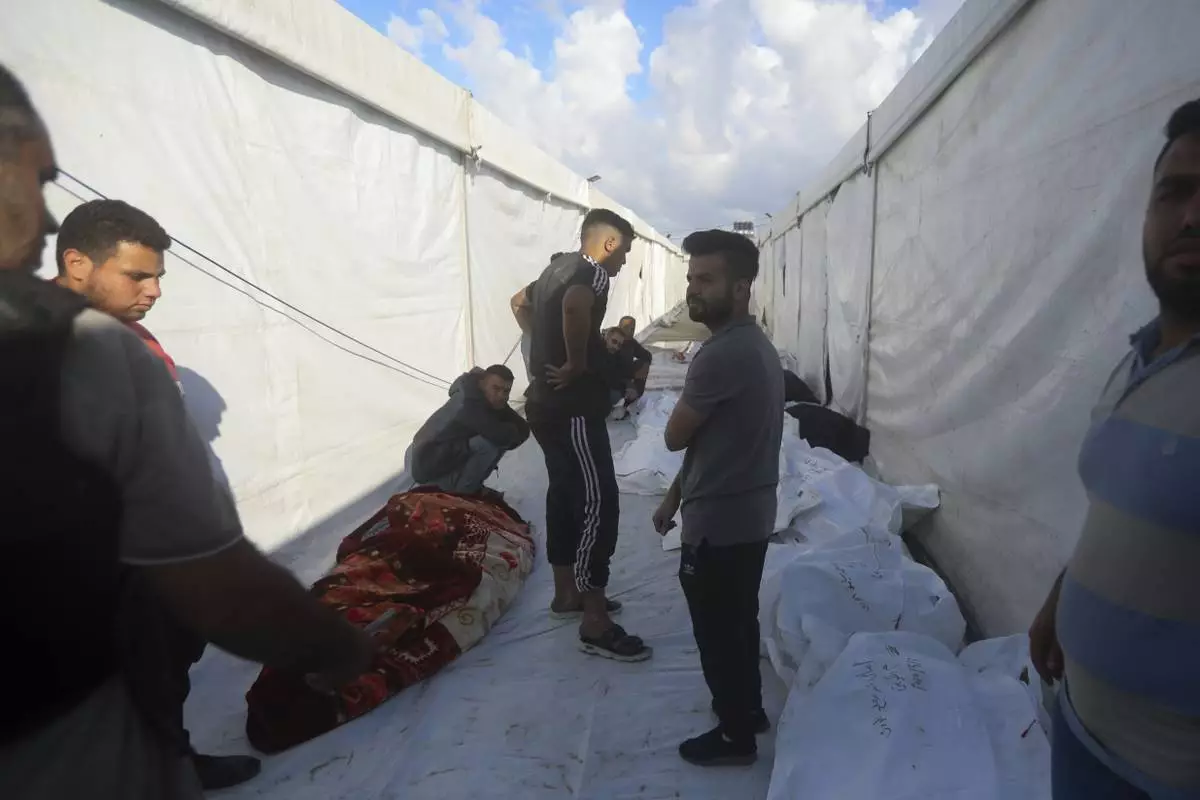
Palestinians mourn their relatives killed in the Israeli bombardment in Rafah, Gaza Strip, Tuesday, May 7, 2024. (AP Photo/Ismael Abu Dayyah)

Palestinians look at the destruction after an Israeli strike on residential building in Rafah, Gaza Strip, Tuesday, May 7, 2024. (AP Photo/Ismael Abu Dayyah)
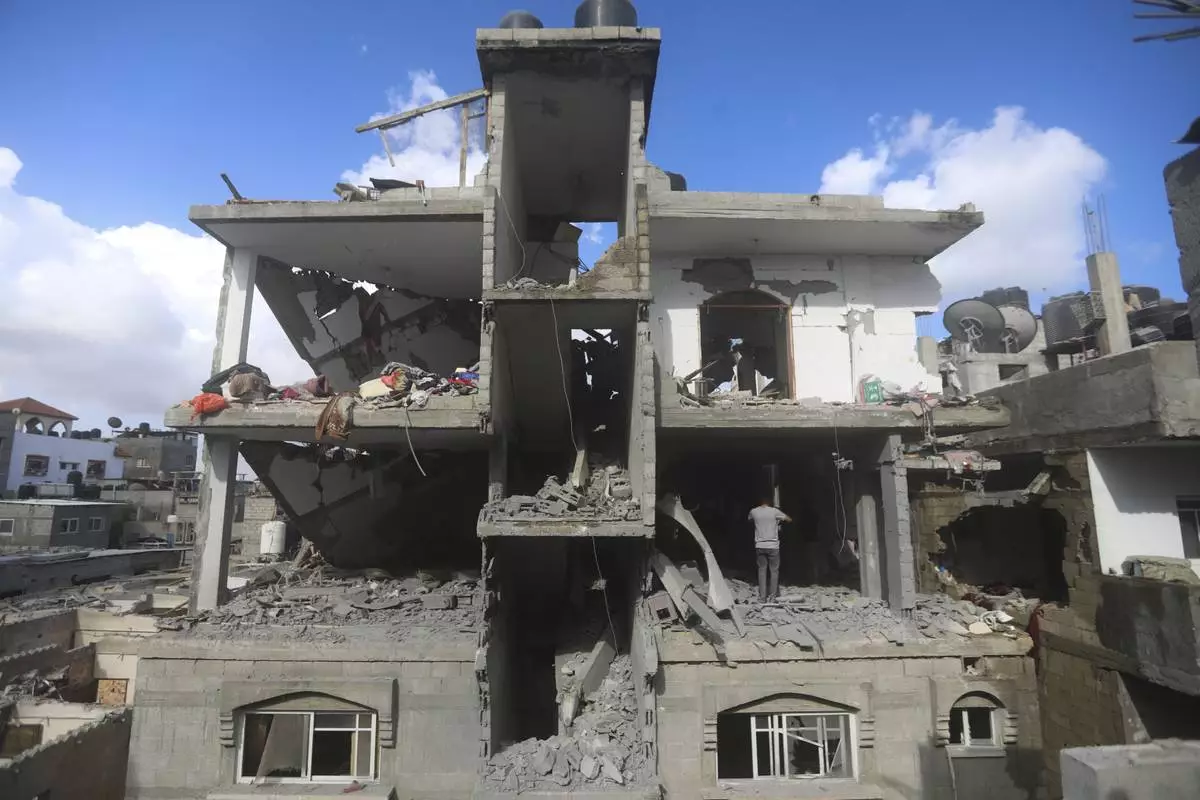
Palestinians look at the destruction after an Israeli strike on residential building in Rafah, Gaza Strip, Tuesday, May 7, 2024. (AP Photo/Ismael Abu Dayyah)
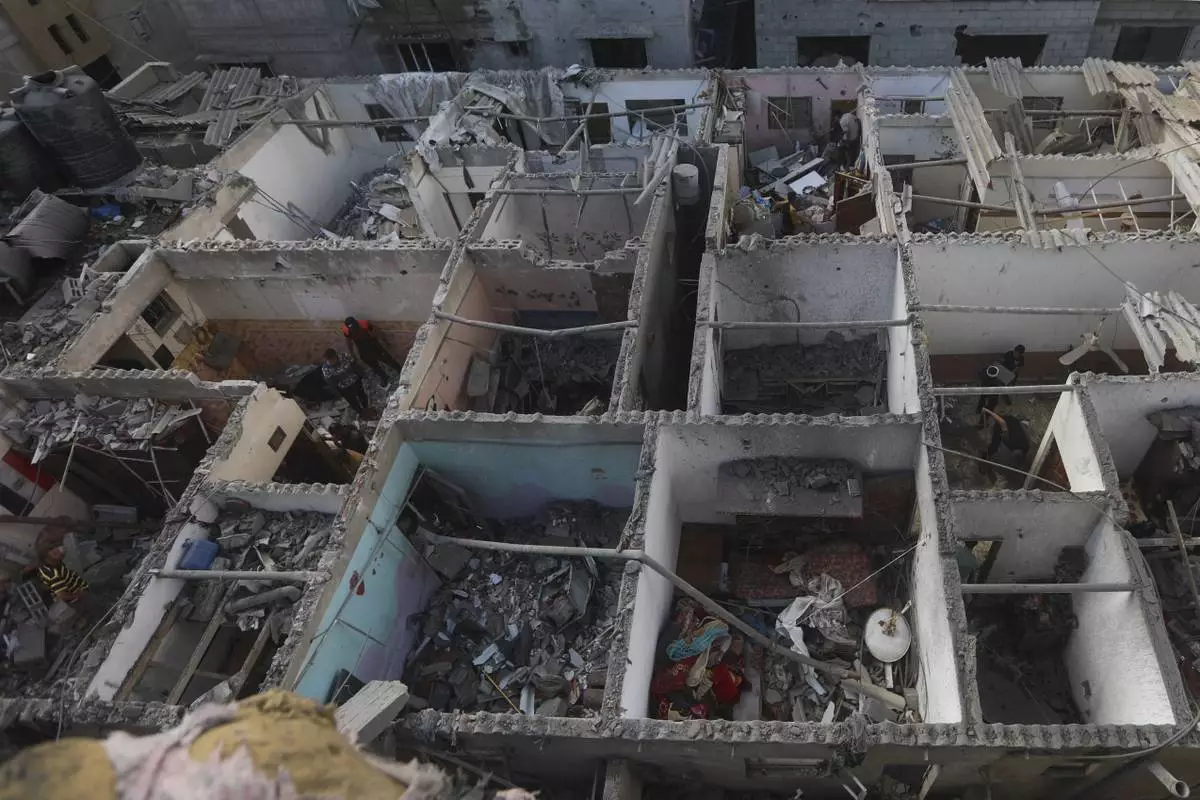
Palestinians look at the destruction after an Israeli strike on residential building in Rafah, Gaza Strip, Tuesday, May 7, 2024. (AP Photo/Ismael Abu Dayyah)
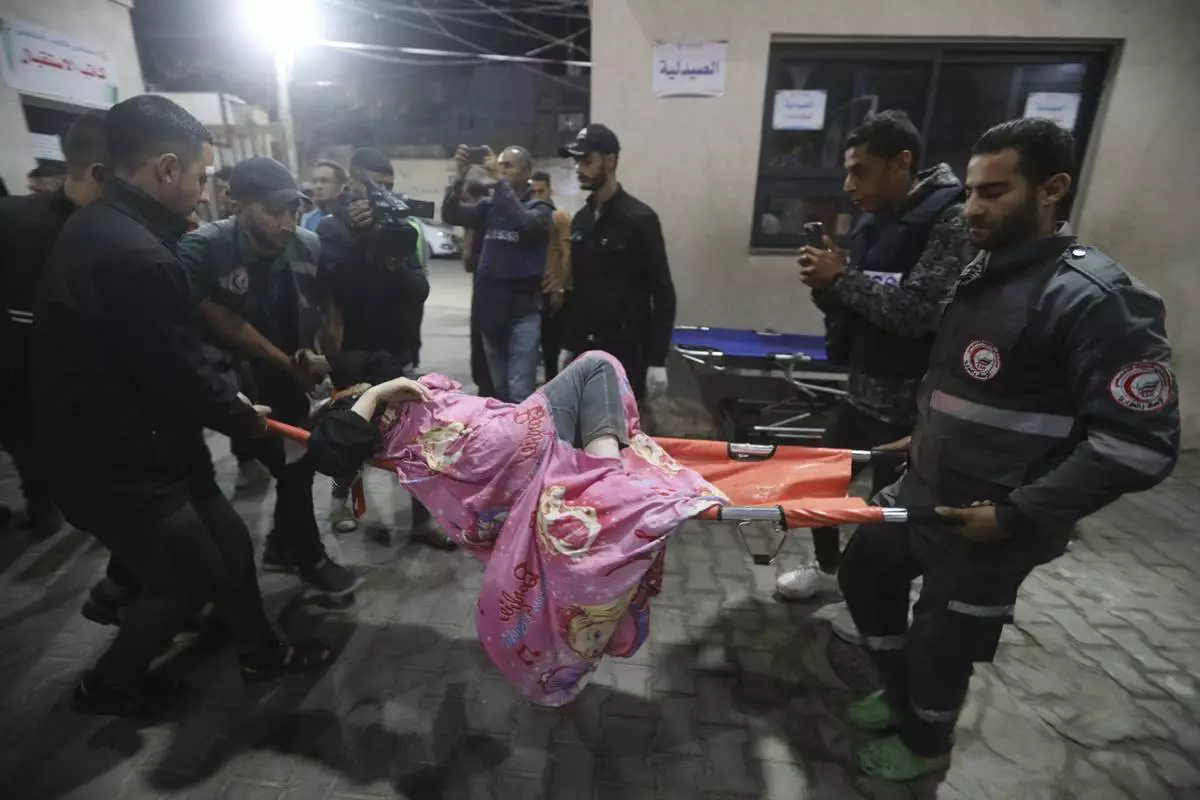
A Palestinian wounded in the Israeli bombardment of the Gaza Strip is brought to a hospital in Rafah, southern Gaza Strip, Tuesday, May 7, 2024. (AP Photo/Ismael Abu Dayyah)
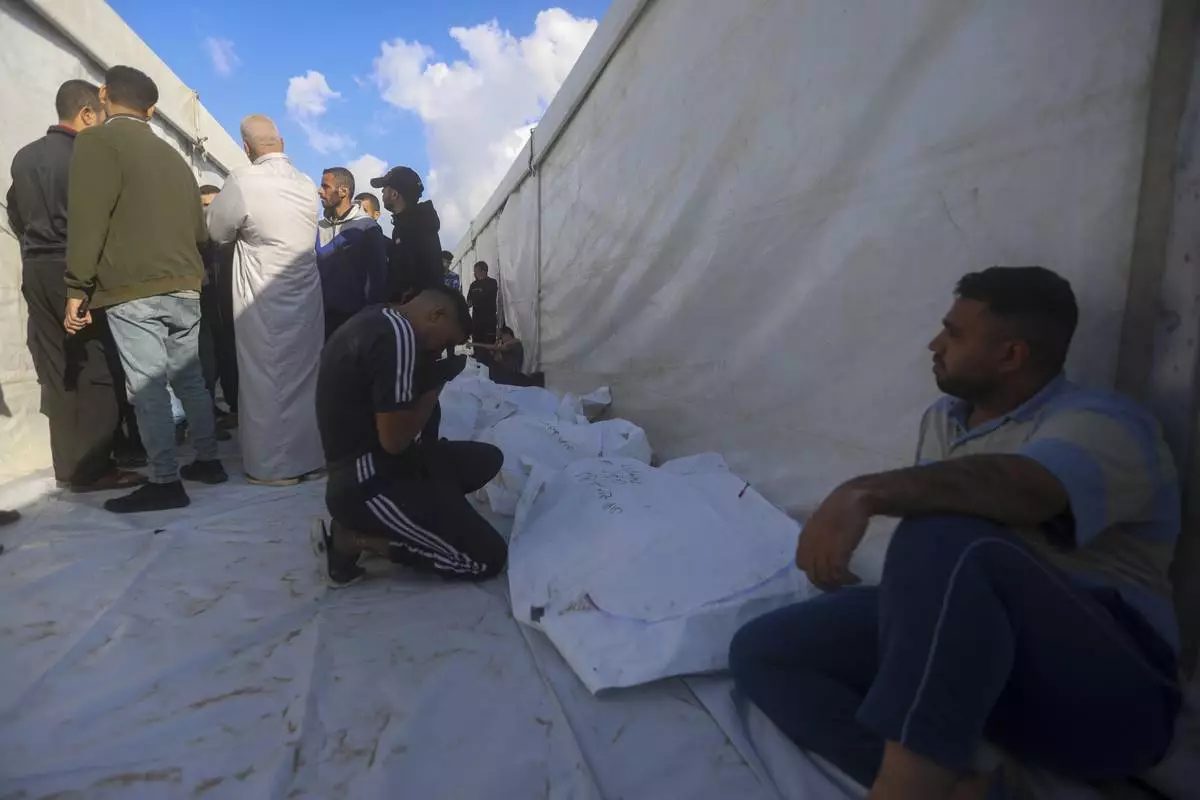
Palestinians mourn their relatives killed in the Israeli bombardment in Rafah, Gaza Strip, Tuesday, May 7, 2024. (AP Photo/Ismael Abu Dayyah)
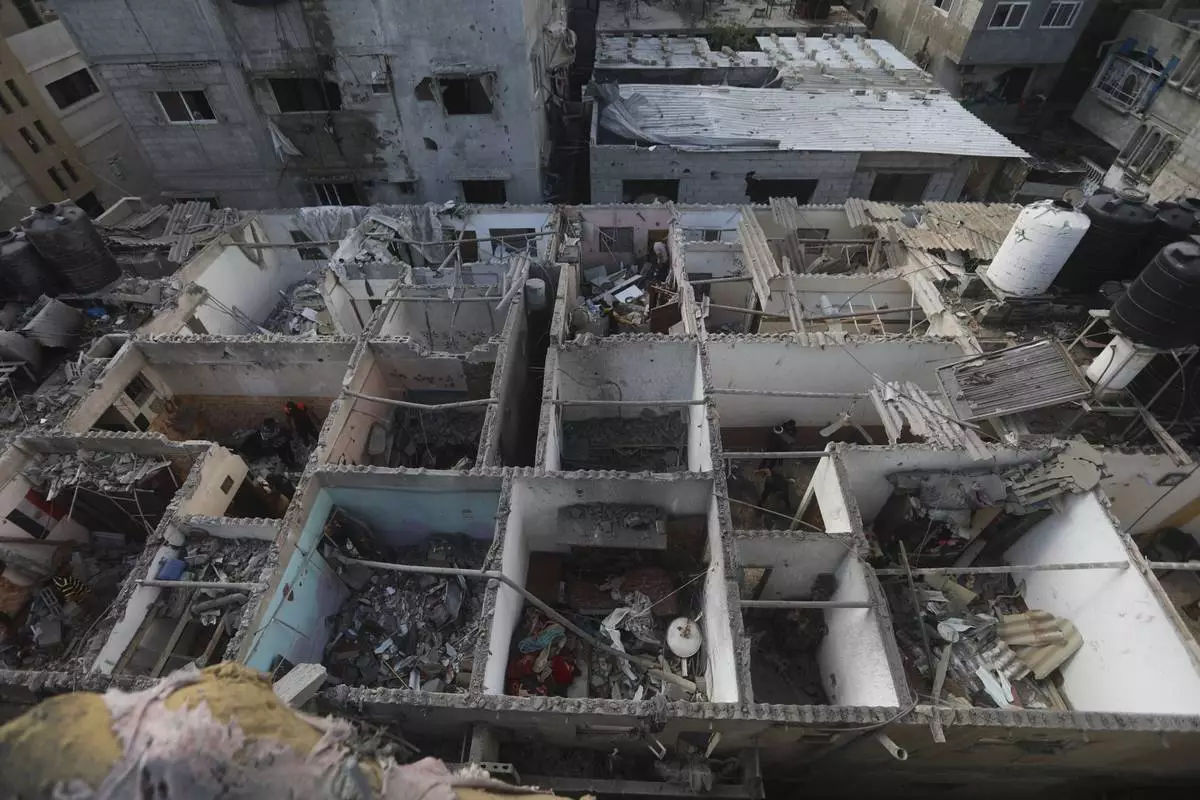
Palestinians look at the destruction after an Israeli strike on residential building in Rafah, Gaza Strip, Tuesday, May 7, 2024. (AP Photo/Ismael Abu Dayyah)
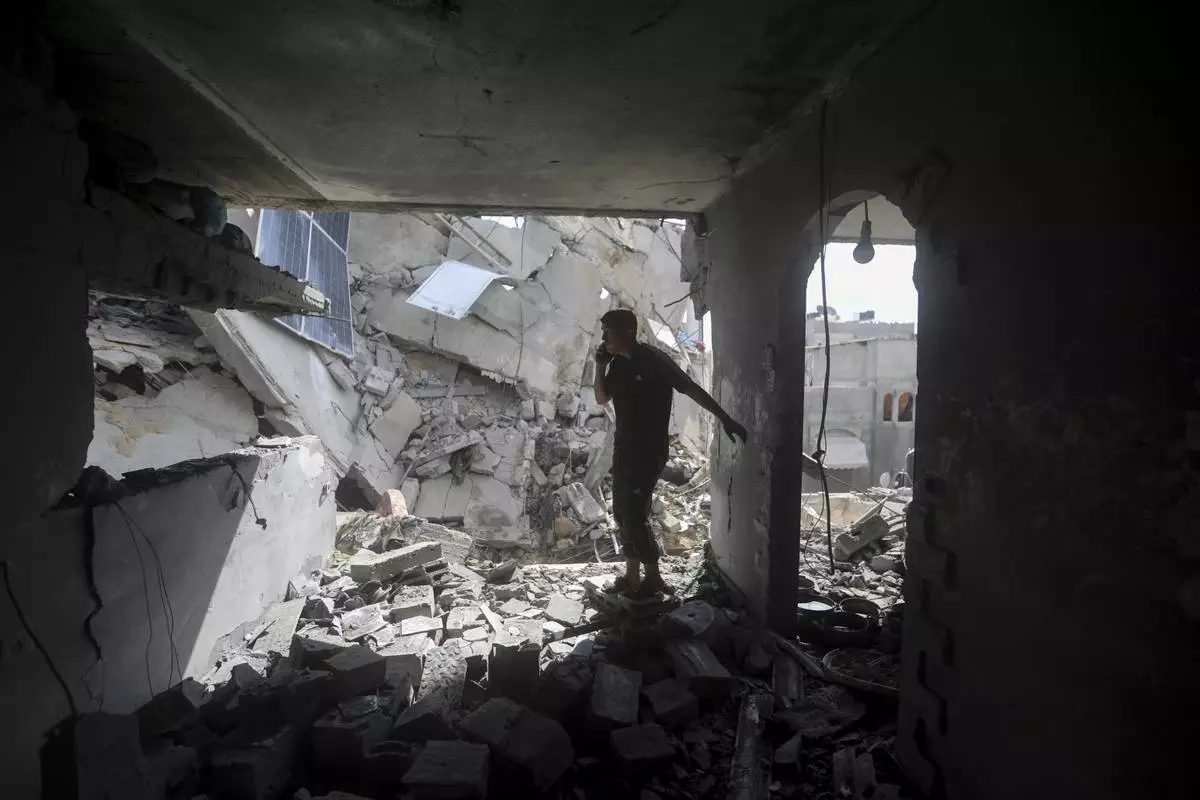
Palestinians look at the destruction after an Israeli strike on residential building in Rafah, Gaza Strip, Tuesday, May 7, 2024. (AP Photo/Ismael Abu Dayyah)

This photo provided by the Israel Defense Forces shows a tank with an Israel flag on it entering the Gazan side of the Rafah border crossing on Tuesday, May 7, 2024. (Israel Defense Forces via AP)

Smoke rises following an Israeli airstrike on buildings near the separating wall between Egypt and Rafah, southern Gaza Strip, Monday, May 6, 2024. (AP Photo/Ramez Habboub)
A long-planned series of Catholic pilgrimages has begun across the United States this weekend, with pilgrims embarking on four routes before converging on Indianapolis in two months for a major gathering focusing on Eucharistic rites and devotions.
The National Eucharistic Pilgrimage is beginning with Masses and other events in California, Connecticut, Minnesota and Texas. A small group of pilgrims plan to walk entire routes, but most participants are expected to take part for smaller segments. Each route goes along country roads and through city centers, with multiple stops at parishes, shrines and other sites.
Although it was forged amid a recent debate among bishops over whether to refuse Communion to U.S. politicians who don’t oppose abortion, the pilgrimage is a revival of a historic Catholic tradition that faded by the mid-20th century.
Each procession is being led by a priest holding a monstrance — typically a sunburst-patterned vessel that displays the host, or bread wafer consecrated by a priest at Mass.
The Catholic Church teaches the “whole Christ is truly present — body, blood, soul, and divinity — under the appearances of bread and wine,” according to the U.S. Conference of Catholic Bishops. As a result, the consecrated host becomes an object of devotion.
“The Eucharist is actually Jesus, so for us to walk with Jesus is actually a witness to our faith in a prayerful action for unity, for peace," said Tim Glemkowski, CEO of the National Eucharistic Congress, the umbrella organization for the events.
The four lengthy pilgrimages appear to be unprecedented, Glemkowski said.
“It’s hard in a 2,000-year-old church to do something for the first time, but a procession this long, with this many people in it, may be the first time this has been attempted in the history of the Catholic Church,” Glemkowski said.
Some pilgrims were embarking Sunday from the headwaters of the Mississippi River in Minnesota. Others planned to embark from a cathedral in Brownsville, Texas, or cross San Francisco's Golden Gate Bridge.
In New Haven, Connecticut, commemorations began with a Saturday night Mass and a mini-procession around St. Mary's Church, which is the burial site of the 19th century founder of the Knights of Columbus fraternal organization, the Rev. Michael McGivney. After an all-night vigil of prayer and adoration, pilgrims were bringing the host to another New Haven church and later to a boat to carry it to the city of Bridgeport and the next leg of the pilgrimage.
The pilgrimage amounts to an effort to revive a type of mass devotion that was once more common in past generations of Catholicism in the U.S. and beyond.
The pilgrimages — and the concluding National Eucharistic Congress, expected to draw tens of thousands to Lucas Oil Stadium in Indianapolis in July — is being funded by private donors, sponsors and ticket sales, Glemkowski said. The budget for the National Eucharistic Revival — which is actually a three-year process that has included parish activities as well as the pilgrimages and congress — is about $23 million, with $14 million of that for the congress, he said.
There have been nine previous U.S. gatherings under the name of the National Eucharistic Congress — but none since 1941.
“We just kind of lost track of this tradition,” Glemkowski said. “We’re bringing it back in a way that fits this time.”
Glemkowski said the pilgrimage is not a march and would avoid politics. “That message of unity and peace and just focus on Christ is paramount,” he said.
The idea for these pilgrimages sprang from deliberations among U.S. bishops.
Their 2021 document, “The Mystery of the Eucharist in the Life of the Church,” arose amid debate over whether bishops should withhold Communion from Catholic politicians who supported abortion rights. The document ultimately did not directly address that, though it called on Catholics to examine whether they align with church teachings and said bishops have a “special responsibility” to respond to "public actions at variance with the visible Communion of the church and the moral law.”
At the same time, the document reflected bishops’ worries that many Catholics don’t know or accept the church’s teachings about the significance of the sacrament, though surveys have given mixed results on that question.
Timothy Kelly, professor of history at Saint Vincent College in Latrobe, Pennsylvania, said it's an open question how many participants the pilgrimage will draw. His 2009 book, “The Transformation of American Catholicism," documents the rise and decline of stadium-sized devotional activities such as Eucharistic adoration in 20th century Pittsburgh.
Many early 20th century Catholics were from immigrant communities, and they often gathered at times of flood, war or other crises. “A lot of times in the older demonstrations, the message seemed to be outward toward the broader community — the Catholics bearing witness to their presence and their faith, but also saying, ‘We’re here and we matter.’”
But participation began dropping sharply by the 1950s. “What happened was the laity stopped being interested in it,” Kelly said.
The Eucharistic pilgrimage, he said, appears to be attracting the most interest in Catholic media sympathetic with other efforts to revive older traditions, such as the Latin Mass.
“Which makes me curious, how well does this resonate within the broader Catholic community?” he said.
Associated Press religion coverage receives support through the AP’s collaboration with The Conversation US, with funding from Lilly Endowment Inc. The AP is solely responsible for this content.

The Eucharistic host is held in a monstrance during a procession outside of St. Mary's Church, Saturday, May 18, 2024, in New Haven, Conn. The Eucharistic Procession from St. Mary's Church is one of four pilgrimage routes crossing the country and converging at the National Eucharistic Congress in Indianapolis, July 16. (AP Photo/Jessica Hill)

The Eucharistic host is held in a monstrance during a procession outside of St. Mary's Church, Saturday, May 18, 2024, in New Haven, Conn. The Eucharistic Procession from St. Mary's Church is one of four pilgrimage routes crossing the country and converging at the National Eucharistic Congress in Indianapolis, July 16. (AP Photo/Jessica Hill)

The Eucharistic host is held in a monstrance during a procession outside of St. Mary's Church, Saturday, May 18, 2024, in New Haven, Conn. The Eucharistic Procession from St. Mary's Church is one of four pilgrimage routes crossing the country and converging at the National Eucharistic Congress in Indianapolis, July 16. (AP Photo/Jessica Hill)

The Eucharistic host is held in a monstrance during a Pentecost Vigil at Blessed Michael McGivney Parish at St. Mary's Church, Saturday, May 18, 2024, in New Haven, Conn. The Eucharistic Procession from St. Mary's Church is one of four pilgrimage routes crossing the country and converging at the National Eucharistic Congress in Indianapolis, July 16. (AP Photo/Jessica Hill)

Two boys hold candles during a Pentecost Vigil at Blessed Michael McGivney Parish at St. Mary's Church, Saturday, May 18, 2024, in New Haven, Conn. The Eucharistic Procession from St. Mary's Church is one of four pilgrimage routes crossing the country and converging at the National Eucharistic Congress in Indianapolis, July 16. (AP Photo/Jessica Hill)

The Most Rev. Christopher J. Coyne, archbishop of Hartford, leads a Pentecost Vigil at Blessed Michael McGivney Parish in St. Mary's Church, Saturday, May 18, 2024, in New Haven, Conn. The Eucharistic Procession from St. Mary's Church is one of four pilgrimage routes crossing the country and converging at the National Eucharistic Congress in Indianapolis, July 16. (AP Photo/Jessica Hill)

The Most Rev. Christopher J. Coyne, archbishop of Hartford, raises a chalice during a Pentecost Vigil at Blessed Michael McGivney Parish in St. Mary's Church, Saturday, May 18, 2024, in New Haven, Conn. The Eucharistic Procession from St. Mary's Church is one of four pilgrimage routes crossing the country and converging at the National Eucharistic Congress in Indianapolis, July 16. (AP Photo/Jessica Hill)

Altar boys hold their hands close to a flame to keep it from blowing out during a Pentecost Vigil at Blessed Michael McGivney Parish in St. Mary's Church, Saturday, May 18, 2024, in New Haven, Conn. The Eucharistic Procession from St. Mary's Church is one of four pilgrimage routes crossing the country and converging at the National Eucharistic Congress in Indianapolis, July 16. (AP Photo/Jessica Hill)

People pray during a Pentecost Vigil at St. Mary's Church, Saturday, May 18, 2024, in New Haven, Conn. The Eucharistic Procession from St. Mary's Church is one of four pilgrimage routes crossing the country and converging at the National Eucharistic Congress in Indianapolis, July 16. (AP Photo/Jessica Hill)

People kneel during a Pentecost Vigil at Blessed Michael McGivney Parish at St. Mary's Church, Saturday, May 18, 2024, in New Haven, Conn. The Eucharistic Procession from St. Mary's Church is one of four pilgrimage routes crossing the country and converging at the National Eucharistic Congress in Indianapolis, July 16. (AP Photo/Jessica Hill)

Nuns listen during a Pentecost Vigil at Blessed Michael McGivney Parish in St. Mary's Church, Saturday, May 18, 2024, in New Haven, Conn. The Eucharistic Procession from St. Mary's Church is one of four pilgrimage routes crossing the country and converging at the National Eucharistic Congress in Indianapolis, July 16. (AP Photo/Jessica Hill)

The Most Rev. Christopher J. Coyne, archbishop of Hartford, walks in a procession during a Pentecost Vigil at Blessed Michael McGivney Parish in St. Mary's Church, Saturday, May 18, 2024, in New Haven, Conn. The Eucharistic Procession from St. Mary's Church is one of four pilgrimage routes crossing the country and converging at the National Eucharistic Congress in Indianapolis on July 16. (AP Photo/Jessica Hill)



















